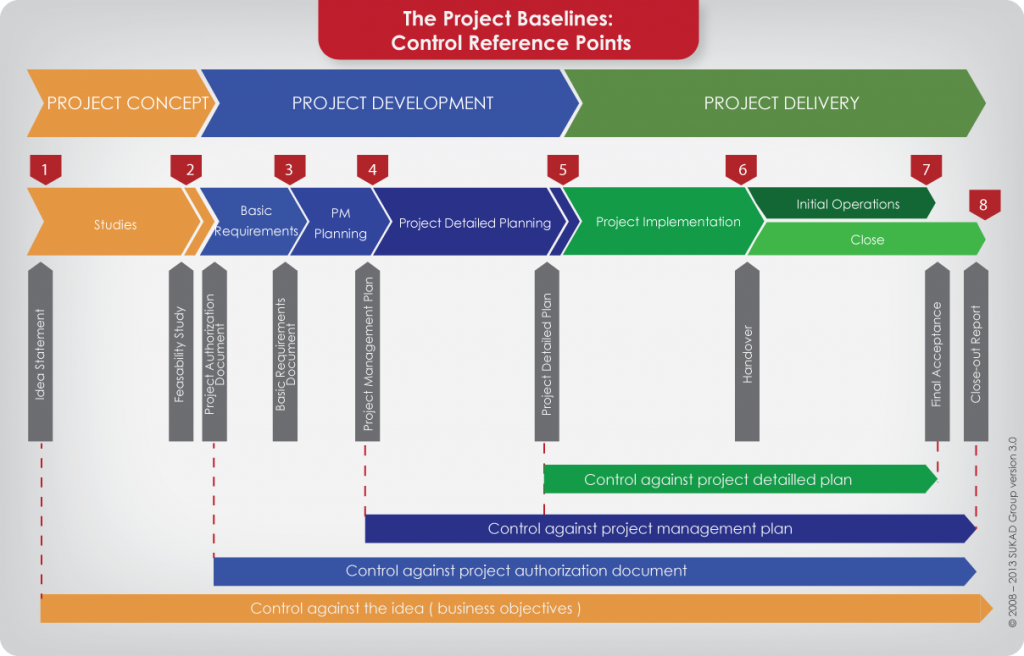This is part 2 of a 4-part series on project change management. This topic is a chapter in our upcoming book, Redefining the Basics of Project Management, scheduled for second quarter 2014.
Project Change Management
The Hidden Changes – Scope Creep
In the previous article we touched on the concept of control reference points and present them graphically in this illustration.
One major justification for these control reference points is ‘Scope Creep’; yes creep as in sneak in, creepy, sinister … or whatever other term the reader prefers to use.
Why does scope creep happen on projects?
- The Project Authorization Document (PAD) is quite high level, lacks details, and therefore leaves room for interpretation.
- Even the basic requirements document and project management plan do not have the same level of detail as the project detailed plan.
- We also know that in project management as the project progresses the level of detail increases.
Due to the above factors, it is often difficult to decide what is a natural variation, a conscious change, or a normal expansion of the project details due to progressive elaboration. Although it is difficult, we know that with proper due diligence it is usually possible to tell the difference between a variation, a change, and design growth.
Time for an example.
The example focuses on the air conditioning system for a villa.
Pre-Launch Stage
Let us say we want to build a nice large villa, with a three-car garage and a garden, among other features. The villa will have air conditioning and heating but the garage will not. The project is feasible and management authorizes it.
Launch Stage
During this stage, the architect/engineer works on the concept design and determines the approximate size of the air conditioning unit, at this point, a ‘10’[1]. Its cost is included in the Class 2 Estimate that we develop in this stage.
Definition Stage
As the project move into detailed planning, the team will have a better idea about the house size, details, windows, and insulation. The team must revisit the air conditioning size and determines that it should be a size 11, a 10% growth. This is normal design growth due to progressive elaboration.
Based on the detailed design, we put enough for a size 11 system in the budget.
When the team investigates availability in the market, they find out that there are only sizes 10, 12, and larger. What do we do? Whether we undersize to 10 or oversize to 12, we do have a variation from plan. This is a market driven variance.
So far, we have:
- 10% growth due to design development, and
- About 10% growth due to market conditions.
These are normal and expected in any project and if we keep records from past projects then we might even have expected them and included them in our estimate. To be clear, we might not have known the exact variations or magnitude but we know these things happen; ‘the known unknowns’.
Let us continue.
As the work is progressing, still in definition stage, the owner decides to air condition the garage, resulting in an increase in the unit size to 15. This would be a change to the objective, or at least to the project management plan.
In this case, the market variance is not relevant anymore and the growth due to the change is from size 11 to size 15.
Notice that if we have adopted the traditional view of control, which is control against the detailed plan, then the air conditioning unit would be size 15 in the PDP. Since we have size 15 in the PDP, then the Class 3 Estimate needs to include a budget allocation for this larger size. This is a 50% growth over the Class 2 Estimate.
If we had not kept records and imposed the project change management system during project definition, we would have missed this change. In other words, we hid the growth and the change into the project detailed plan.
No big deal!
It is a big deal.
The air conditioning unit increased in size from 10 to 15, a fifty percent (50%) growth and only ten percent of that was due to normal progression of design (from 10 to 11). This growth in size had a corresponding growth in cost, and possibly schedule or risk, among other factors. In other words, the actual magnitude of the change would have gone unnoticed if we had not implemented multiple control points.


Trackbacks/Pingbacks